Surgeons require exceptional visual information in the operating room. Many displays now claim "4K" capability. Can you trust that all these displays offer the same critical performance for surgical procedures?
No, not all 4K surgical displays are the same. True surgical-grade 4K monitors offer specialized features for superior clarity, extremely low latency, consistent color uniformity, and robustness designed for demanding OR conditions, which generic 4K displays often lack.

The term "4K" has become widespread, but its meaning in a surgical setting goes far beyond a simple pixel count. The ability to visualize fine anatomical details, differentiate subtle tissue variations, and react in real-time during complex procedures depends heavily on the specific attributes of the surgical display1. In this discussion, I will explain the key differences that distinguish a true clinical-grade 4K surgical monitor2 from other displays that may also carry the 4K label. We will explore why these differences are critical for patient safety and surgical success3.
What does 4K resolution mean in a surgical context?
The operating room demands the highest level of precision. When a display is labeled "4K," does it simply mean more pixels on the screen? It is important to understand what 4K truly signifies for surgical outcomes.
In a surgical context, 4K resolution (3840×2160 pixels) means enhanced visual detail critical for procedures. It also implies essential attributes like low latency, consistent color accuracy, and durability vital for the operating room environment.
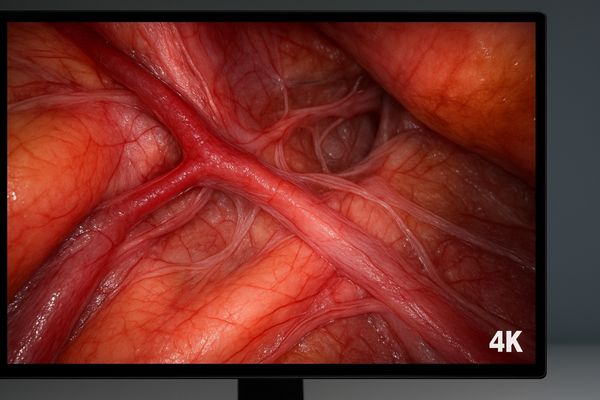
When we refer to 4K resolution4 in a surgical display, we are indeed talking about a screen with 3840 horizontal pixels and 2160 vertical pixels. This results in approximately 8.3 million individual pixels, four times the number found in a Full HD (1920×1080) display. This increased pixel density translates directly to a sharper, more detailed image. Surgeons can discern finer structures, such as small blood vessels, nerve fibers, or subtle variations in tissue texture, with greater ease. However, in the demanding environment of surgery, 4K means more than just pixel density. It encompasses the display’s ability to render these pixels with clarity. This clarity is crucial for accurately identifying anatomical landmarks and distinguishing between healthy and pathological tissue. Low latency is another vital component. This refers to the minimal delay between the surgical camera capturing an image and that image appearing on the screen. In real-time, image-guided procedures, any noticeable lag can disrupt hand-eye coordination. Color uniformity and accuracy are also paramount. The display must consistently represent colors across the entire screen and ensure that these colors faithfully reproduce what the camera sees. This is essential for accurate tissue identification and assessment. Finally, robustness is a key consideration. Surgical displays must withstand the rigors of the OR, including frequent cleaning with harsh disinfectants and potential minor impacts. Therefore, 4K in a surgical context is a holistic concept, combining high resolution with performance characteristics tailored for critical medical applications.
Table 1: 4K UHD vs. Full HD in Surgical Visualization
| Feature | Full HD (1920×1080) | 4K UHD (3840×2160) | Surgical Implication of 4K UHD |
|---|---|---|---|
| Total Pixels | ~2.1 million | ~8.3 million | Significantly more detail, improved structure differentiation |
| Pixel Density (32") | ~69 PPI | ~138 PPI | Sharper images, reduced pixelation, clearer fine details |
| Visual Clarity | Good | Excellent | Better visualization of micro-structures, tissue textures |
| Depth Perception | Standard | Potentially Enhanced | More information for improved spatial understanding |
This comparison highlights how the jump to 4K resolution provides a substantial increase in the visual data available to the surgeon.
Do all 4K surgical monitors provide the same image performance?
Many 4K displays are now available on the market. However, a crucial question arises: are all of them actually built to meet the stringent demands of surgical precision? It is important to learn how performance can vary dramatically among them.
No, not all 4K surgical monitors provide the same image performance. Significant differences in underlying panel quality, achievable luminance levels, color gamut coverage, and specialized image processing capabilities greatly impact their suitability for precise surgical tasks.
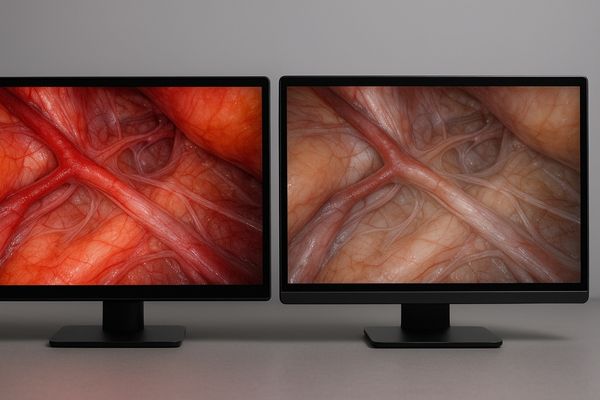
While many manufacturers may claim their displays are 4K, the actual image performance can differ substantially, especially between commercial-grade panels and those designed specifically for medical use. Commercial panels, often found in consumer televisions or general-purpose monitors, might achieve the 4K resolution standard. However, they frequently lack the high luminance (brightness) required to overcome the bright ambient lighting typically found in operating rooms. If a display is not sufficiently bright, crucial details in shadowed areas of the surgical site can be obscured. Furthermore, the color gamut5, which refers to the range of colors a display can reproduce, is often limited in commercial panels. Surgical procedures, particularly endoscopy, rely on accurate color rendition to differentiate between various tissue types, identify bleeding, or assess perfusion. Medical-grade surgical monitors aim for wider color gamuts, such as full sRGB or even DCI-P3, and ensure color accuracy through precise calibration. This ensures that the colors seen on screen are a faithful representation of the actual surgical site. Another critical differentiator is medical-grade image processing6. Surgical displays incorporate advanced algorithms designed to enhance details, reduce image noise from endoscopic cameras, and optimize clarity specifically for medical video signals. These processing capabilities are typically absent or less sophisticated in commercial displays. Consequently, using a 4K display with a commercial panel for precise endoscopic or image-guided procedures can be unsuitable and may even compromise the surgeon’s ability to perform optimally. The subtle nuances visible on a high-performance medical display might be entirely lost on a lesser screen.
How do brightness, contrast, and latency affect surgical safety?
Surgical safety is an absolute priority in any medical procedure. Display specifications like brightness, contrast, and latency might seem like minor technical details. However, it is vital to understand how these features directly impact patient outcomes.
Inadequate brightness (e.g., below 400 cd/m²), low contrast (e.g., under 1000:1), or high latency (e.g., exceeding 50ms) can severely impair depth perception and edge clarity. This directly risks surgical precision, potentially leading to complications and disrupting the surgical workflow.
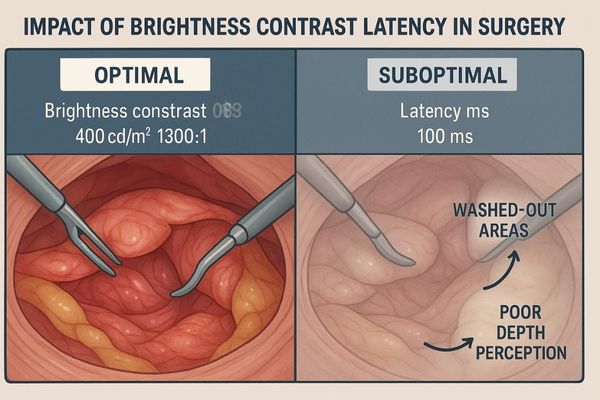
Brightness, contrast7, and latency are not just abstract numbers; they have tangible effects on a surgeon’s ability to operate safely and effectively. Sufficient brightness is crucial for illuminating the surgical field, especially in deep cavities or when dealing with shadows cast by instruments or anatomical structures. If a monitor’s brightness8 is too low, typically below 400 candelas per square meter (cd/m²), subtle details can be lost, making it harder to identify critical structures or bleeding points. High contrast, ideally 1000:1 or better, is essential for differentiating between various tissue planes and clearly defining the edges of organs and instruments. Poor contrast can make the image appear washed out, reducing the perception of depth and making it difficult to judge distances accurately. This can directly impact the precision of surgical maneuvers. Latency, the delay between an action and its display on screen, is perhaps one of the most critical factors for safety in dynamic procedures like laparoscopy or robotic surgery. If latency9 exceeds an acceptable threshold, often cited around 30-50 milliseconds (ms), the surgeon’s hand-eye coordination can be disrupted. This means the visual feedback on the monitor does not precisely match the surgeon’s movements, leading to potential overshooting, instrument collisions, or inaccurate dissections. Such delays can impair the surgical workflow, increase procedure time, and, most importantly, elevate the risk of iatrogenic injury. Therefore, ensuring optimal levels of brightness, contrast, and minimal latency are fundamental to maintaining surgical safety.
Table 2: Key Display Parameters and Surgical Safety Implications
| Parameter | Recommended Minimum/Maximum | Risk if Below/Above Recommendation | Impact on Surgical Safety |
|---|---|---|---|
| Brightness | > 400 cd/m² | Poor visibility in shadows, details obscured by OR lights | Increased risk of missing subtle pathologies or bleeding points |
| Contrast Ratio | > 1000:1 | Washed-out image, poor edge definition, reduced depth perception | Difficulty in differentiating tissue planes, instrument error |
| Latency | < 30-50 ms | Delayed visual feedback, poor hand-eye coordination | Risk of imprecise movements, instrument collision, tissue damage |
| Color Gamut | Close to 100% sRGB / Rec.709 | Inaccurate tissue color representation | Misinterpretation of tissue health, vascularity |
These parameters are interconnected and collectively contribute to the overall visual quality and safety profile of the surgical display.
What role do coatings and glass design play in surgical 4K monitors?
The operating room is an undeniably demanding and often harsh environment. A common question is whether the screen on a surgical display is merely a fragile window to the image. It is important to discover how specialized glass protects both the image and the patient.
Coatings and specialized glass design in surgical 4K monitors provide essential glare reduction, robust protection against liquids and physical damage, and often include antimicrobial properties. This ensures sustained image clarity and supports critical hygiene protocols in the OR.
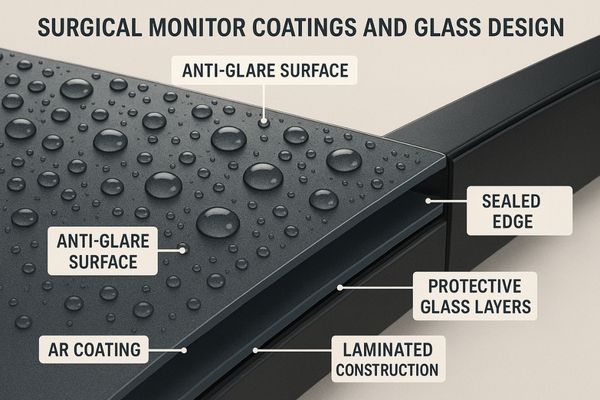
The front surface of a surgical monitor is more than just a piece of glass; it is an engineered component crucial for performance and safety. True surgical 4K displays often feature fully laminated, Anti-Reflective (AR) treated tempered glass1. Full lamination, also known as optical bonding, involves adhering the protective glass directly to the LCD panel, eliminating the air gap found in many consumer displays. This process reduces internal reflections, improves contrast, and increases the overall robustness of the screen, making it more resistant to impacts. The AR treatment is vital for minimizing glare and reflections from the bright, focused overhead lights common in operating rooms. Excessive glare can obscure critical details on the screen and cause significant eye fatigue for the surgical team. Tempered glass is used for its increased strength and safety. If it does break, it shatters into small, relatively harmless granular pieces rather than sharp shards. Furthermore, surgical monitors2 are designed with ingress protection in mind, often achieving IP ratings like IP65 on the front surface. This indicates a high degree of protection against dust and liquid intrusion, which is essential given the frequent cleaning with disinfectants and the potential for fluid splashes during procedures. Many medical-grade displays also incorporate antimicrobial coatings on the housing and screen. These coatings help inhibit the growth of bacteria and other microorganisms, contributing to infection control efforts in the sterile OR environment. Additional layers for scratch resistance and anti-smudge properties help maintain optical clarity over time, despite repeated cleaning and handling.
Table 3: Common Coatings and Protections for Surgical Displays
| Feature | Benefit in Surgical Environment |
|---|---|
| Anti-Reflective (AR) | Reduces glare from OR lights, improves image visibility, reduces eye strain |
| Laminated/Bonded Glass | Improves contrast, reduces internal reflection, increases durability |
| Tempered Glass | Enhanced impact resistance, safer breakage pattern |
| IP Rating (e.g., IP65 front) | Protection against liquid splashes and dust, allows for thorough cleaning |
| Antimicrobial Coating | Inhibits microbial growth, supports infection control protocols |
| Scratch-Resistant Layer | Maintains screen clarity despite frequent cleaning and contact |
| Anti-Smudge Coating | Reduces fingerprints and smudges, easier to keep clean |
These features collectively ensure that the display not only performs well optically but also withstands the unique challenges of the surgical setting.
How does Reshin ensure clinical-grade performance in its 4K surgical monitors?
Choosing the right surgical display is a vital decision for any healthcare institution. A common concern is how one can be absolutely sure of its performance and reliability in critical situations. I want to explain how we build reliability and clinical excellence into every unit.
Reshin ensures clinical-grade performance in its 4K surgical monitors, like the MS430PC, through features such as 10-bit color depth, robust DICOM support for image consistency, very low latency (sub-30ms), and versatile multi-input designs. These are tailored for demanding modern surgical applications.
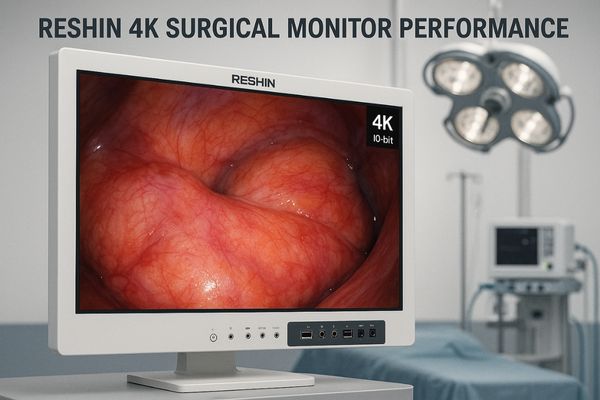
We ensure clinical-grade performance in our 4K surgical monitors by focusing on key technological attributes critical for the operating room. For example, many of our displays, including the MS430PC 4K surgical monitor, utilize 10-bit color depth10. This allows the monitor to display over a billion distinct color shades, resulting in smoother color transitions and finer gradations. In surgery, this translates to a more accurate representation of tissue tones, vascularity, and subtle pathological changes, which can be crucial for diagnostic assessment and precise dissection. While DICOM (Digital Imaging and Communications in Medicine) is primarily associated with radiology, DICOM Part 14 grayscale calibration11 support in surgical displays ensures consistency with pre-operative imaging viewed on diagnostic monitors. This is increasingly important for image-guided surgery and for correlating intraoperative findings with pre-operative scans. Extremely low latency is a non-negotiable requirement. Our surgical displays are engineered to achieve sub-30 millisecond latency12. This near-instantaneous image update is vital for maintaining precise hand-eye coordination, especially during minimally invasive procedures where surgeons rely entirely on the monitor’s view. A versatile multi-input design is also standard. This allows seamless connection to a wide array of OR equipment, including 4K endoscopes, surgical cameras, C-arms, ultrasound systems, and 3D navigation platforms. This flexibility ensures compatibility and supports complex, hybrid imaging setups. By combining these features, we provide monitors that meet the demanding requirements of modern surgical practice, supporting clearer visualization, enhanced precision, and improved workflow efficiency.
Conclusion
True surgical 4K displays are highly specialized tools, not merely high-resolution screens. They are engineered with specific features for clarity, speed, color accuracy, and durability that are essential for patient safety in the demanding OR environment. To equip your OR with purpose-built 4K surgical displays, contact Reshin at martin@reshinmonitors.com.
-
Discover the critical attributes of surgical displays that improve visualization and decision-making during surgeries. This resource will provide valuable insights. ↩ ↩
-
Understanding the unique features of clinical-grade 4K surgical monitors is essential for ensuring patient safety and surgical success. Explore this link to learn more. ↩ ↩
-
Explore the connection between high-quality surgical displays and improved patient outcomes, emphasizing the importance of technology in modern surgery. ↩
-
Understanding 4K resolution is essential for appreciating its impact on surgical precision and image clarity. ↩
-
Learn about the importance of color gamut in medical imaging and how it impacts surgical procedures and diagnostics. ↩
-
Discover how advanced image processing in medical displays enhances clarity and detail, crucial for successful surgeries. ↩
-
Exploring the impact of contrast on surgical imaging can help improve the differentiation of tissue planes, crucial for successful surgeries. ↩
-
Understanding the role of brightness in surgical monitors can enhance surgical safety and effectiveness, ensuring better visibility during procedures. ↩
-
Learning about latency in surgical settings can reveal its significant effects on hand-eye coordination and overall surgical safety. ↩
-
Understanding 10-bit color depth can enhance your knowledge of surgical monitor technology and its impact on surgical outcomes. ↩
-
Exploring DICOM Part 14 can provide insights into how surgical displays maintain imaging consistency, crucial for effective surgeries. ↩
-
Learning about latency in surgical displays can help you appreciate the technology that supports precision in minimally invasive procedures. ↩


